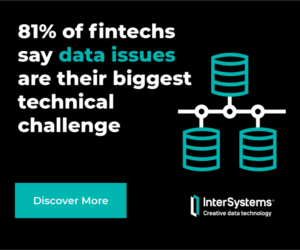
How Do You Approach Your Data in a New Way by Making It Smarter
by Kenneth Kuek, Sales Lead for South East Asia at InterSystems February 23, 2022In the era of rising customer expectations and savvier consumers, financial organisations are under increased pressure to provide customers with hyper-personalised experiences.
In fact, more than half of customers expect to always have personalised offers and 66 percent expect companies to understand their unique needs and expectations.
This puts significant pressure on banks and other financial organisations to leverage data in strategic ways to deliver a much higher level of individualisation than ever before.
Technology will be the key to maintaining or bolstering business’s competitive advantage, which will be evident in the predicted banking trends for 2022.
Smart data fabrics is emerging as a key trend at the forefront of innovation, operational improvements, and customer insights.
What are smart data fabrics?

Source: Ocelia Mg via Adobe Stock
Data is only valuable if it provides insights that the organisation can use to drive actions and decision-making.
This means that financial organisations can only benefit from the vast amounts of data they collect and store if they have an effective way to extract those insights, and a strategy for incorporating data-led decision-making into the business.
A data fabric interweaves humans and different types of technology, creating an architectural design that manages data faster and in a more simplified way.
Data fabrics transform businesses internally by improving data transparency, harmonising data from multiple sources, and deciphering it into usable, actionable insights.
Smart data fabrics take this concept even further. A smart data fabric embeds an array of analytics capabilities, including business intelligence (BI), machine learning (ML), artificial intelligence (AI), data exploration, and natural language processing (NLP), into the fabric.
It lets organisations continue to leverage legacy systems and applications because the smart data fabric can still use the data from these.
This means organisations can still capitalise on previous technology investments, including data lakes and warehouses, without having to replace existing technology.
Smart data fabrics can also be used to power intelligent predictive and prescriptive services and applications on demand.
This will make it much faster, easier, and more simplified for banks and fintechs to gain more in-depth insights at every customer touchpoint.
How do smart data fabrics help financial organisations?

Source: Jonathan Cooper via Unsplash
Smart data fabrics provide banks and fintechs with greater visibility and control over who uses data and for what purpose.
This will be particularly relevant when it comes to meeting the changing regulatory requirements around the globe.
There are three specific ways that a smart data fabric can benefit financial institutions:
1. Maximising the value of existing systems
Rather than having to ‘rip and replace’ existing applications and software, a smart data fabric can interconnect this data to provide analysed insights from across the organisation. This even includes data stored in lakes and warehouses.
This means that businesses can still maximise the value from previously implemented technology investments.
2. Building resiliency and compliance with a single source of truth
Business data is fluid and ever-increasing, and organisations need to collect, store, process, and analyse copious amounts of structured and unstructured data each day.
This can make it easy for data to get lost and forgotten about in applications or data warehouses.
When this happens, insights are derived from incomplete data, which can compromise the quality of decisions and actions taken as a result of those insights.
A smart data fabric can harmonise the data from across the organisation, creating a single source of truth and providing transparency.
The organisation can then have confidence that the decisions and actions are based on complete and accurate data.
3. Overcoming complex data management and governance challenges
Banks and fintechs face evolving management and compliance requirements from industry governing agencies, stakeholders, and global government regulations.
Without a structured data fabric that can provide transparency within an organisation, adhering to these requirements can be especially challenging.
A smart data fabric provides the business with a data governance policy that can help overcome compliance challenges by using tools such as ML and AI to discover, map, and classify data throughout the business.
With the pressure on banks and financial organisations to provide tailored experiences for individual clients, data will be more important than ever to shape these experiences.
An organisation’s ability to scale will matter even more as financial firms compete on technology, according to McKinsey, to accommodate for growth, stakeholder requirements, and data.
Download InterSystems’ e-book on “The Global Fintech Landscape: Challenges, Collaboration, and Cloud” for more details here.








